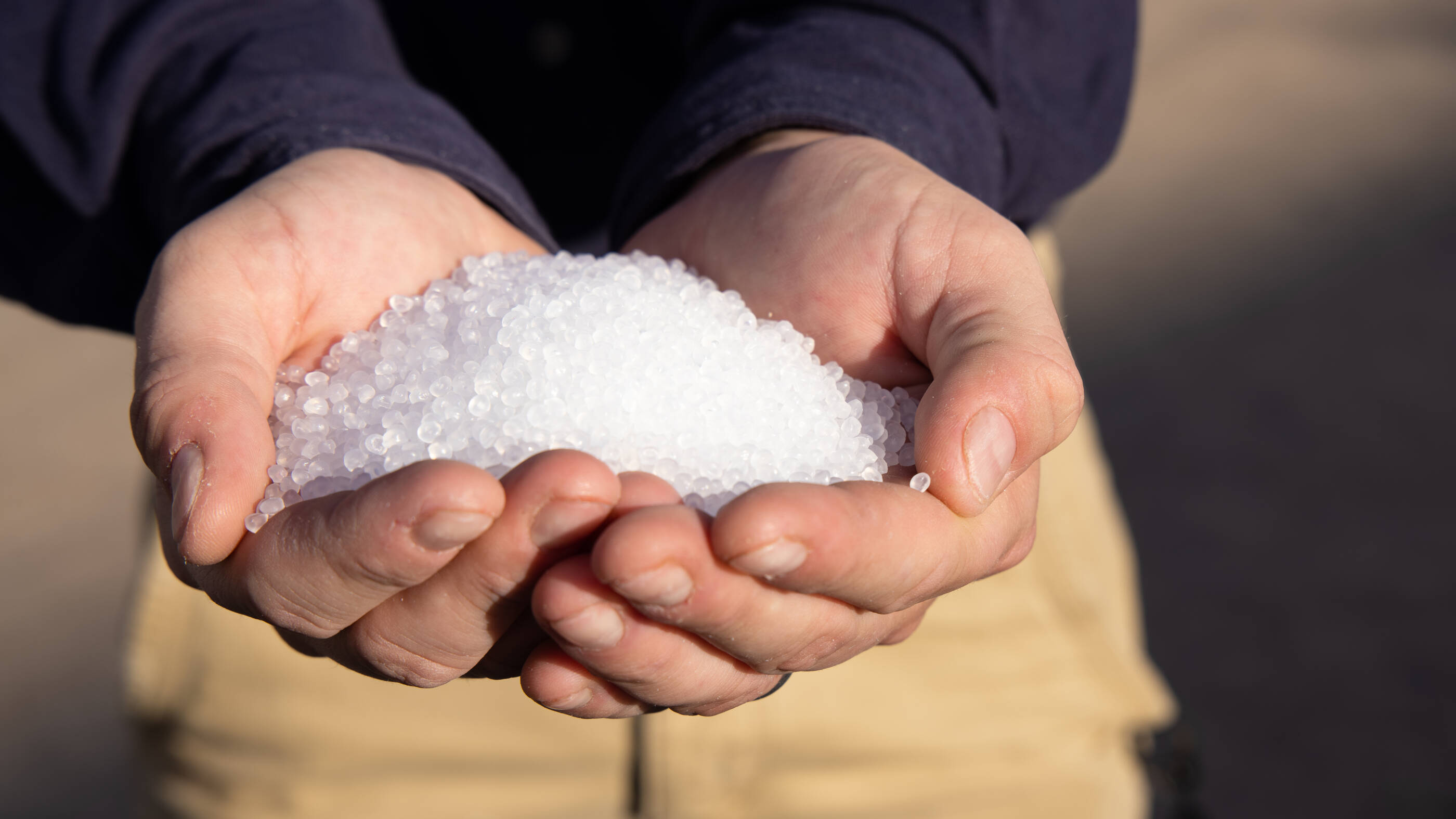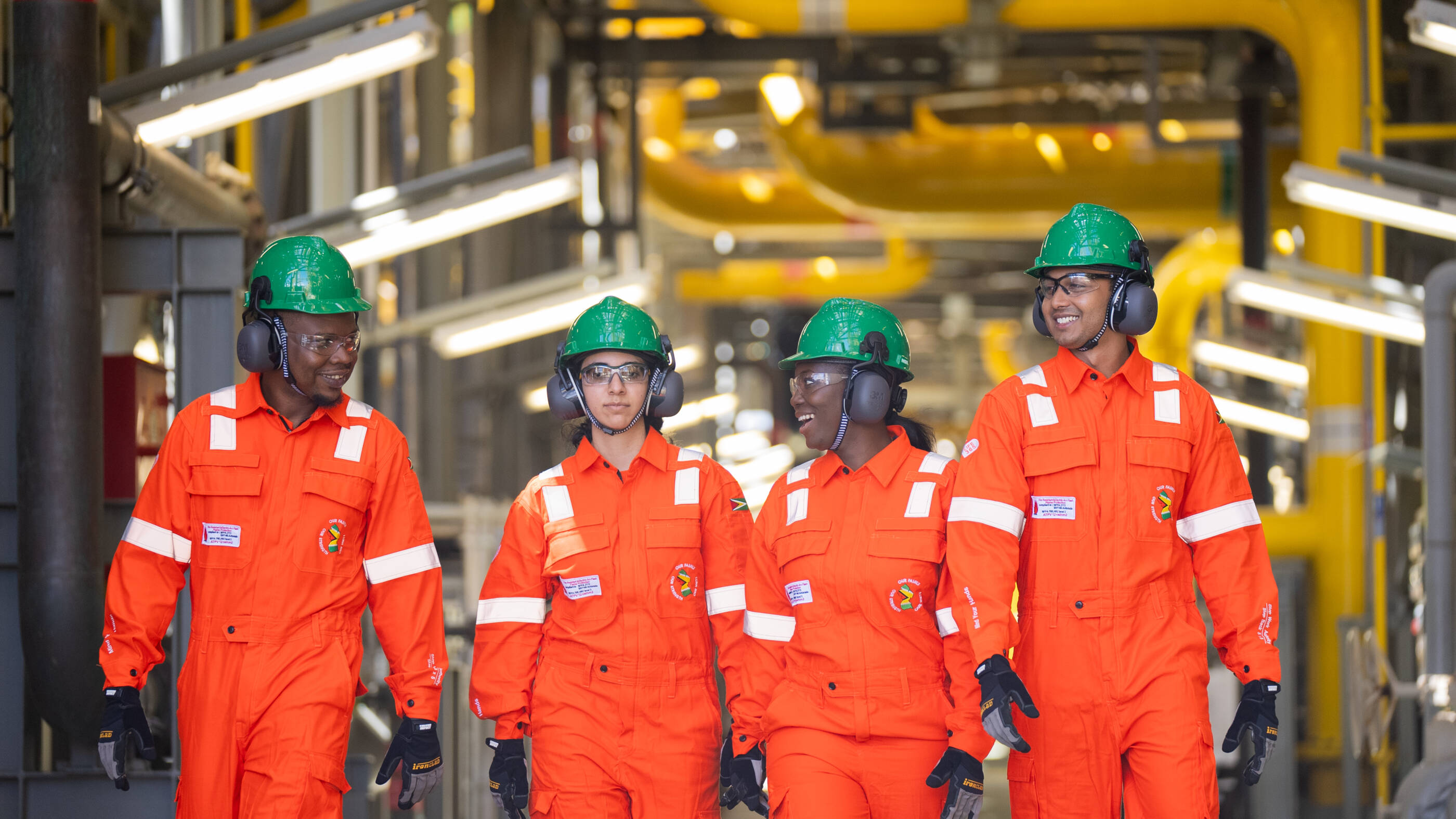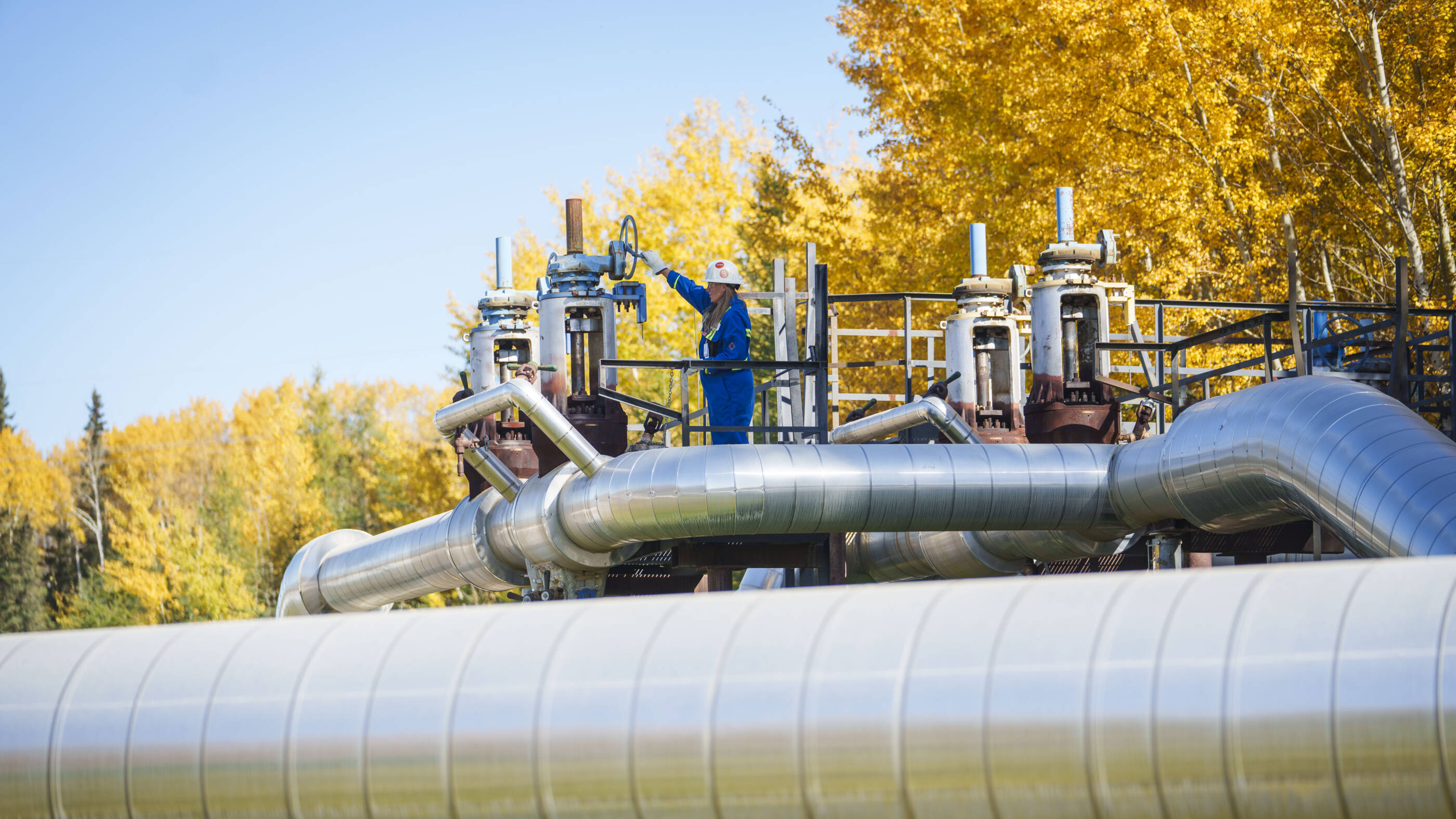4 min read
• April 30, 2025Minimizing operational waste
Everyone at ExxonMobil plays a role in reducing operational waste. And the first step is finding ways to avoid it entirely.
4 min read
• April 30, 2025Navigate to:

Our use of a waste mitigation hierarchy prioritizes waste avoidance when feasible. When it’s not, we work to reduce, recover, or reuse waste whenever possible.
We aim to dispose of waste only if other options have been exhausted, and we have robust processes to select waste sites that meet our high standards and expectations.
We regularly review and improve methods for managing waste at our facilities. On-site waste personnel are trained on effective waste controls, applicable regulations, and our own environmental practices. Corporate and regional staff provide technical guidance on waste reduction and recycling opportunities
Our approach
We work to avoid generating waste and take a broad range of measures to mitigate and eliminate waste that is generated.
To do that, we use a waste mitigation hierarchy that starts with waste avoidance.
We are committed to the management and treatment of waste in a manner that incorporates industry best practices.
These measures include source reduction, reuse, recycling, reclamation, handling, storage, and transportation, as well as treatment and/or disposal of any remaining waste in compliance with applicable regulations.
What is a waste mitigation hierarchy?
A waste mitigation hierarchy is commonly used by businesses, governments, and even individuals to prioritize waste management practices to minimize waste.
It consists of five stages:
- Avoid waste: Facilities are designed and operated to be efficient and to optimize the materials and feedstocks used.
- Reduce | Recover | Reuse: Systems are in place to separate oil from water and solids, so oil is recovered and water can be reused. Where practical, waste materials are collected and sent for reuse, such as making fuel.
- Recycle: Through the waste segregation processes, we collect materials like paper, plastic, electronics, aluminum, used oil, filters, glycols, scrap metal, tires, batteries, and aerosol cans to be recycled.
- Treat: Where appropriate, impacted soil and groundwater at our operating and surplus sites are treated to reduce waste volume or eliminate contaminants.
- Dispose: When necessary, we dispose of materials in an environmentally responsible manner (e.g., through our Waste Facility Risk Assessment Program).
We continuously look for ways to minimize waste through practices like process changes; raw material changes; material handling, storage, and transportation; as well as treatment and/or disposal of any remaining waste in compliance with applicable regulations.
spotlight
Operation Clean Sweep (OCS): Best-in-class containment
The joint venture we operate Gulf Coast Growth Ventures near Corpus Christi, Texas, uses extensive controls designed to prevent “nurdles” – the pellets created in our manufacturing of plastics – from escaping to the environment. These controls include:
- Pellet inceptors at the site outfalls.
- Interior unit collection systems.
- Pellet handling enclosures.
The site has maintained a record of zero reportable pellet discharges under OCS Blue reporting standards1 since beginning operations.
Project Waste Management Standard
Our Project Waste Management Standard, part of our overall Project Environmental Standards, informs our project selection and design decisions. These standards help us to:
- Ensure we have infrastructure in place to manage, treat, and dispose of waste from project construction and operations.
- Reduce the quantity of waste and the potential hazards associated with a project.
- Promote waste minimization, recycling, and reuse throughout the life of an asset.
Waste Facility Risk Assessment Program
We are committed to using third-party waste facilities that follow industry best practices for waste management and environmental protection. Through our Waste Facility Risk Assessment Program, we evaluate selected waste facilities in most countries where we operate to make sure they meet our requirements. Facilities are reviewed by internal experts or assessed by independent contractors.
Areas of evaluation include:
|
|
In 2024, 80% of the waste from our operated assets and remediation activities was managed by third-party facilities assessed by independent evaluators. We expect this number to increase as the audit program grows.
Zero Waste to Landfill
In the past two assessments, the global lubes network has achieved Gold validation by demonstrating a more than 95% diversion rate through our efforts to reduce, reuse, and recycle. Solutions as simple as repair and reuse of container pallets and as complex as an advanced distillation process to recover laboratory solvent have enabled us to redeploy to new, productive uses more than 50,000 tons of waste produced per year.
In 2018, ExxonMobil’s global network of lubricants blending and packaging plants, which manufacture all Mobil-branded lubricant products, earned a Zero Waste to Landfill Silver validation from Underwriters Laboratories.2 ExxonMobil was the first petroleum products company to achieve this validation.
Supplier waste management
We aim to work with our suppliers to identify ways to reduce environmental impacts. Our global sourcing strategy encourages consideration of environmental performance including finding and reducing waste and inefficiency in our supply chain.
Decommissioning and rehabilitation
Decommissioning is the process of dismantling, removing and/or finding alternative uses for facilities. Detailed planning and preparation can start up to 10 years before decommissioning activities begin.
Each site is unique. Our approach may vary by location, type of asset, and local environmental and socioeconomic characteristics. The decommissioning process can include a range of activities such as emptying and cleaning of production systems, plugging wells, dismantling structures, and transporting, recycling, or disposing of materials, and restoring local habitats.
In 2024, we developed five decommissioning principles for both onshore and offshore, reflecting our comprehensive approach. These were rolled out to our decommissioning practitioners company-wide in 2025.

Our decommissioning plans incorporate applicable regulatory requirements and globally accepted practices. We aim to be responsive to concerns and opportunities identified through external engagements and integrate the results into our decommissioning plans where appropriate.
Decommissioning an offshore asset can be complex and present unique challenges. At these assets, our plans consider specific marine ecosystems and facility characteristics, including complexity, size, and weight.
The Sable energy project in Canada, for example, started its life in late 1959, when exploration near Nova Scotia began. As Canada’s first offshore natural gas project, Sable provided decades of strategic benefits and billions of dollars of economic benefits to the region. By 2020, wells were plugged and abandoned, onshore processing plants were dismantled, and offshore and onshore pipelines were cleaned and flushed. That same year, all seven of Sable’s offshore platforms were removed, and about 99% of the materials were recycled.
In 2024, nearly 17% of the material generated from decommissioning our significant onshore projects was diverted from landfills.3
Rehabilitation is the process of safely repurposing assets that no longer support our operations. Our goal is to prevent legacy impacts on the environment while creating opportunities for beneficial reuse.
When divesting real property, we work to identify ways to return it to beneficial reuse. ExxonMobil Environmental and Property Solutions (E&PS) is our global organization that supports the remediation and stewardship of surplus onshore sites. From the group’s creation in 2008 through 2024, E&PS has managed more than $9.3 billion of onshore remediation work and returned 4,000 properties to beneficial end uses. In 2024, E&PS managed approximately 3,400 active remediation onshore sites in 22 countries. Beginning in 2025, the acquired assets from Denbury and Pioneer will be incorporated into our portfolio as we continue the integration into our business.
Publications
Explore more

Expanding the plastics life cycle
3 min read
• April 30, 2025
Integrating sustainability into what we do
5 min read
• April 30, 2025
Working with suppliers

Enhancing process safety
3 min read
• April 30, 2025
Improving air quality
2 min read
• April 30, 2025
FOOTNOTES:
- For more details visit OCS Blue - Operation Clean Sweep
- Network includes the owned or contracted plants that blend and package all the Mobil-branded lubricant products sold by ExxonMobil or its affiliates; excludes products manufactured and sold by third parties under a license. (Footnote added for clarity on November 25, 2025.)
- Does not include Denbury or Pioneer data.
FORWARD-LOOKING STATEMENT WARNING
Images or statements of future ambitions, aims, aspirations, plans, goals, events, projects, projections, opportunities, expectations, performance, or conditions in the publications, including plans to reduce, abate, avoid or enable avoidance of emissions or reduce emissions intensity, sensitivity analyses, expectations, estimates, the development of future technologies, business plans, and sustainability efforts are dependent on future market factors, such as customer demand, continued technological progress, stable policy support and timely rule-making or continuation of government incentives and funding, and represent forward-looking statements. Similarly, emission-reduction roadmaps to drive toward net zero and similar roadmaps for emerging technologies and markets, and water management roadmaps to reduce freshwater intake and/or manage disposal, are forward-looking statements. These statements are not guarantees of future corporate, market or industry performance or outcomes for ExxonMobil or society and are subject to numerous risks and uncertainties, many of which are beyond our control or are even unknown.
Actual future results, including the achievement of ambitions to reach Scope 1 and 2 net zero from operated assets by 2050, to reach Scope 1 and 2 net zero in heritage Permian Basin unconventional operated assets by 2030, and in Pioneer Permian assets by 2035, to eliminate routine flaring in-line with World Bank Zero Routine Flaring, to reach near zero methane emissions from operated assets and other methane initiatives to meet ExxonMobil’s greenhouse gas emission reduction plans and goals, divestment and start-up plans, and associated project plans as well as technology advances, including in the timing and outcome of projects to capture, transport and store CO2, produce hydrogen and ammonia, produce lower-emission fuels, produce ProxximaTM systems, produce carbon materials, produce lithium, and use plastic waste as feedstock for advanced recycling; future debt levels and credit ratings; business and project plans, timing, costs, capacities and profitability; resource recoveries and production rates; planned Denbury and Pioneer integrated benefits; obtain data on detection, measurement and quantification of emissions including reporting of that data or updates to previous estimates and progress in sustainability focus areas could vary depending on a number of factors, including global or regional changes in oil, gas, petrochemicals, or feedstock prices, differentials, seasonal fluctuations, or other market or economic conditions affecting the oil, gas, and petrochemical industries and the demand for our products; new market products and services; future cash flows; our ability to execute operational objectives on a timely and successful basis; the ability to realize efficiencies within and across our business lines; new or changing government policies for lower carbon and new market investment opportunities, or policies limiting the attractiveness of investments such as European taxes on energy and unequal support for different methods of carbon capture; developments or changes in local, national, or international treaties, laws, regulations, taxes, trade sanctions, trade tariffs, and incentives affecting our business, including those related to greenhouse gas emissions, plastics, carbon storage and carbon costs; timely granting of governmental permits and certifications; uncertain impacts of deregulation on the legal and regulatory environment; evolving reporting standards for these topics and evolving measurement standards for reported data; trade patterns and the development and enforcement of local, national and regional mandates; unforeseen technical or operational difficulties; the outcome of research efforts and future technology developments, including the ability to scale projects and technologies such as electrification of operations, advanced recycling, carbon capture and storage, hydrogen and ammonia production, ProxximaTM systems, carbon materials or direct lithium extraction on a commercially competitive basis; the development and competitiveness of alternative energy and emission reduction technologies; unforeseen technical or operating difficulties, including the need for unplanned maintenance; availability of feedstocks for lower-emission fuels, hydrogen, or advanced recycling; changes in the relative energy mix across activities and geographies; the actions of co-venturers competitors; changes in regional and global economic growth rates and consumer preferences including willingness and ability to pay for reduced emissions products; actions taken by governments and consumers resulting from a pandemic; changes in population growth, economic development or migration patterns; timely completion of construction projects; war, civil unrest, attacks against the Company or industry, and other political or security disturbances, including disruption of land or sea transportation routes; decoupling of economies, realignment of global trade and supply chain networks, and disruptions in military alliances; and other factors discussed here and in Item 1A. Risk Factors of our Annual Report on Form 10-K and under the heading “Factors affecting future results” available under the “Earnings” tab through the “Investors” page of our website at www.exxonmobil.com. The Advancing Climate Solutions Report includes 2024 greenhouse gas emissions performance data as of March 1, 2025, and Scope 3 Category 11 estimates for full year 2024 as of February 19, 2025. The greenhouse gas intensity and greenhouse gas emission estimates include Scope 2 market-based emissions. The Sustainability Report, the Advancing Climate Solutions Report, and corresponding Executive Summaries were issued on April 30, 2025. The content and data referenced in these publications focus primarily on our operations from Jan. 1, 2024 – Dec. 31, 2024, unless otherwise indicated. Tables on our “Metrics and data” page were updated to reflect full year 2024 data. Information regarding some known events or activities in 2025 and historical initiatives from prior years are also included. No party should place undue reliance on these forward-looking statements, which speak only as of the dates of these publications. All forward-looking statements are based on management’s knowledge and reasonable expectations at the time of publication. ExxonMobil assumes no duty to update these statements or materials as of any future date, and neither future distribution of this material nor the continued availability of this material in archive form on our website should be deemed to constitute an update or re-affirmation of these figures or statements as of any future date. Any future update will be provided only through a public disclosure indicating that fact.
See “ABOUT THE ADVANCING CLIMATE SOLUTIONS AND SUSTAINABILITY REPORTS” at the end of this document for additional information on these reports and the use of non-GAAP and other financial measures.
ABOUT THE ADVANCING CLIMATE SOLUTIONS AND SUSTAINABILITY REPORTS
The Advancing Climate Solutions Report contains terms used by the TCFD, as well as information about how the disclosures in this report are consistent with the recommendations of the TCFD. In doing so, ExxonMobil is not obligating itself to use any terms in the way defined by the TCFD or any other party, nor is it obligating itself to comply with any specific recommendation of the TCFD or to provide any specific disclosure. For example, with respect to the term “material,” individual companies are best suited to determine what information is material, under the long-standing U.S. Supreme Court definition, and whether to include this information in U.S. Securities and Exchange Act filings. In addition, the ISSB is evaluating standards that provide their interpretation of TCFD which may or may not be consistent with the current TCFD recommendations. The Sustainability Report and Advancing Climate Solutions Report are each a voluntary disclosure and are not designed to fulfill any U.S., foreign, or third-party required reporting framework.
Forward-looking and other statements regarding environmental and other sustainability efforts and aspirations are not intended to communicate any material investment information under the laws of the United States or represent that these are required disclosures. These publications are not intended to imply that ExxonMobil has access to any significant non-public insights on future events that the reader could not independently research. In addition, historical, current, and forward-looking environmental and other sustainability-related statements may be based on standards for measuring progress that are still developing, internal controls and processes that continue to evolve, and assumptions that are subject to change in the future, including future laws and rulemaking. Forward-looking and other statements regarding environmental and other sustainability efforts and aspirations are for informational purposes only and are not intended as an advertisement for ExxonMobil’s equity, debt, businesses, products, or services and the reader is specifically notified that any investor-requested disclosure or future required disclosure is not and should not be construed as an inducement for the reader to purchase any product or services. The statements and analysis in these publications represent a good faith effort by the Company to address these investor requests despite significant unknown variables and, at times, inconsistent market data, government policy signals, and calculation, methodologies, or reporting standards.
Actions needed to advance ExxonMobil’s 2030 greenhouse gas emission-reductions plans are incorporated into its medium-term business plans, which are updated annually. The reference case for planning beyond 2030 is based on the Company’s Global Outlook research and publication. The Global Outlook is reflective of the existing global policy environment and an assumption of increasing policy stringency and technology improvement to 2050. However, the Global Outlook does not attempt to project the degree of required future policy and technology advancement and deployment for the world, or ExxonMobil, to meet net zero by 2050. As future policies and technology advancements emerge, they will be incorporated into the GIobal Outlook, and the Company’s business plans will be updated as appropriate. References to projects or opportunities may not reflect investment decisions made by the corporation or its affiliates. Individual projects or opportunities may advance based on a number of factors, including availability of stable and supportive policy, permitting, technological advancement for cost-effective abatement, insights from the Company planning process, and alignment with our partners and other stakeholders. Capital investment guidance in lower-emission and other new investments is based on our corporate plan; however, actual investment levels will be subject to the availability of the opportunity set, stable public policy support, other factors, and focused on returns.
Energy demand modeling aims to replicate system dynamics of the global energy system, requiring simplifications. The reference to any scenario or any pathway for an energy transition, including any potential net-zero scenario, does not imply ExxonMobil views any particular scenario as likely to occur. In addition, energy demand scenarios require assumptions on a variety of parameters. As such, the outcome of any given scenario using an energy demand model comes with a high degree of uncertainty. For example, the IEA describes its NZE scenario as extremely challenging, requiring unprecedented innovation, unprecedented international cooperation, and sustained support and participation from consumers, with steeper reductions required each year since the scenario’s initial release. Third-party scenarios discussed in these reports reflect the modeling assumptions and outputs of their respective authors, not ExxonMobil, and their use or inclusion herein is not an endorsement by ExxonMobil of their underlying assumptions, likelihood, or probability. Investment decisions are made on the basis of ExxonMobil’s separate planning process but may be secondarily tested for robustness or resiliency against different assumptions, including against various scenarios. These reports contain information from third parties. ExxonMobil makes no representation or warranty as to the third-party information. Where necessary, ExxonMobil received permission to cite third-party sources, but the information and data remain under the control and direction of the third parties. ExxonMobil has also provided links in this report to third-party websites for ease of reference. ExxonMobil’s use of the third-party content is not an endorsement or adoption of such information.
ExxonMobil reported emissions, including reductions and avoidance performance data, are based on a combination of measured and estimated data. We assess our performance to support continuous improvement throughout the organization using our Environmental Performance Indicator (EPI) manual. The reporting guidelines and indicators in the Ipieca, the American Petroleum Institute (API), the International Association of Oil and Gas Producers Sustainability Reporting Guidance for the Oil and Gas Industry (4th edition, 2020, revised February 2023) and key chapters of the GHG Protocol inform the EPI and the selection of the data reported. Emissions reported are estimates only, and performance data depends on variations in processes and operations, the availability of sufficient data, the quality of those data and methodology used for measurement and estimation. Emissions data is subject to change as methods, data quality, and technology improvements occur, and changes to performance data may be updated. Emissions, reductions, abatements and enabled avoidance estimates for non-ExxonMobil operated facilities are included in the equity data and similarly may be updated as changes in the performance data are reported. ExxonMobil’s plans to reduce emissions are good-faith efforts based on current relevant data and methodology, which could be changed or refined. ExxonMobil works to continuously improve its approach to estimate, detect, measure, and address emissions. ExxonMobil actively engages with industry, including API and Ipieca, to improve emission factors and methodologies, including measurements and estimates.
Any reference to ExxonMobil’s support of, work with, or collaboration with a third-party organization within these publications do not constitute or imply an endorsement by ExxonMobil of any or all of the positions or activities of such organization. ExxonMobil participates, along with other companies, institutes, universities and other organizations, in various initiatives, campaigns, projects, groups, trade organizations, and other collaborations among industry and through organizations like the United Nations that express various ambitions, aspirations and goals related to climate change, emissions, sustainability, and the energy transition. ExxonMobil’s participation or membership in such collaborations is not a promise or guarantee that ExxonMobil’s individual ambitions, future performance or policies will align with the collective ambitions of the organizations or the individual ambitions of other participants, all of which are subject to a variety of uncertainties and other factors, many of which may be beyond ExxonMobil’s control, including government regulation, availability and cost-effectiveness of technologies, and market forces and other risks and uncertainties. Such third parties’ statements of collaborative or individual ambitions and goals frequently diverge from ExxonMobil’s own ambitions, plans, goals, and commitments. ExxonMobil will continue to make independent decisions regarding the operation of its business, including its climate-related and sustainability-related ambitions, plans, goals, commitments, and investments. ExxonMobil’s future ambitions, goals and commitments reflect ExxonMobil’s current plans, and ExxonMobil may unilaterally change them for various reasons, including adoption of new reporting standards or practices, market conditions; changes in its portfolio; and financial, operational, regulatory, reputational, legal and other factors.
References to “resources,” “resource base,” “recoverable resources” and similar terms refer to the total remaining estimated quantities of oil and natural gas that are expected to be ultimately recoverable. The resource base includes quantities of oil and natural gas classified as proved reserves, as well as quantities that are not yet classified as proved reserves, but that are expected to be ultimately recoverable. The term “resource base” is not intended to correspond to SEC definitions such as “probable” or “possible” reserves. For additional information, see the “Frequently Used Terms” on the Investors page of the Company’s website at www.exxonmobil.com under the header “Modeling Toolkit.” References to “oil” and “gas” include crude, natural gas liquids, bitumen, synthetic oil, and natural gas. The term “project” as used in these publications can refer to a variety of different activities and does not necessarily have the same meaning as in any government payment transparency reports.
Exxon Mobil Corporation has numerous affiliates, many with names that include ExxonMobil, Exxon, Mobil, Esso, and XTO. For convenience and simplicity, those terms and terms such as “Corporation,” “company,” “our,” “we,” and “its” are sometimes used as abbreviated references to one or more specific affiliates or affiliate groups. Abbreviated references describing global or regional operational organizations, and global or regional business lines are also sometimes used for convenience and simplicity. Nothing contained herein is intended to override the corporate separateness of affiliated companies. Exxon Mobil Corporation’s goals do not guarantee any action or future performance by its affiliates or Exxon Mobil Corporation’s responsibility for those affiliates’ actions and future performance, each affiliate of which manages its own affairs. For convenience and simplicity, words like venture, joint venture, partnership, co-venturer and partner are used to indicate business relationships involving common activities and interests, and those words may not indicate precise legal relationships. These publications cover Exxon Mobil Corporation’s owned and operated businesses and do not address the performance or operations of our suppliers, contractors or partners unless otherwise noted. In the case of certain joint ventures for which ExxonMobil is the operator, we often exercise influence but not control. Thus, the governance, processes, management and strategy of these joint ventures may differ from those in these reports. At the time of publication, ExxonMobil has completed the acquisitions of Denbury Inc. and Pioneer Natural Resources Company. These reports and the data therein do not speak of these companies’ pre-acquisition governance, risk management, strategy approaches, or emissions or sustainability performance unless specifically referenced.
These reports or any material therein are not to be used or reproduced without the permission of Exxon Mobil Corporation. All rights reserved.
SUPPLEMENTAL INFORMATION FOR NON-GAAP AND OTHER MEASURES
The Positioned for Growth in a Lower-Emission Future section of the Advancing Climate Solutions Report mentions modeled operating cash flow in comparing different businesses over time in a future scenario. Historic operating cash flow is defined as net income, plus depreciation, depletion and amortization for consolidated and equity companies, plus noncash adjustments related to asset retirement obligations plus proceeds from asset sales. The Company’s long-term portfolio modeling estimates operating cash flow as revenue or margins less cash expenses, taxes and abandonment expenditures plus proceeds from asset sales before portfolio capital expenditures. The Company believes this measure can be helpful in assessing the resiliency of the business to generate cash from different potential future markets. The performance data presented in the Advancing Climate Solutions Report and Sustainability Report, including on emissions, is not financial data and is not GAAP data.



